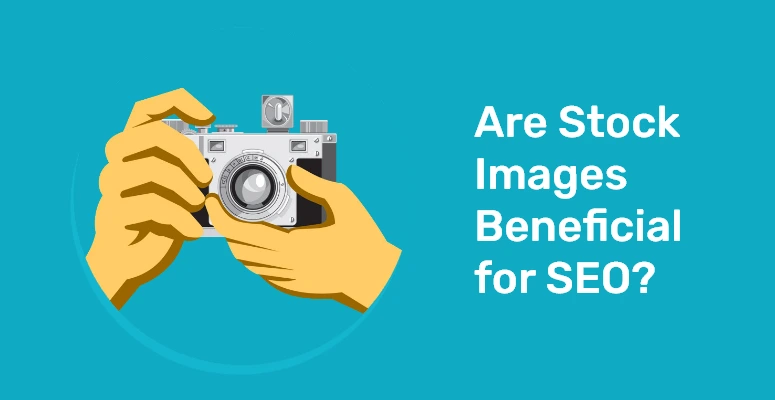
SEO trends have always been the buzz of the town in the world of digital marketing.
In addition, with new algorithms presented day-to-day, marketers are always in a rage to bring that into their content to rank high on search engines.
Recently, digital marketers have had the question of whether stock images are good for SEO or not.
Well, this blog will give you insights into the impact of stock images on SEO.
What are Stock Images in Terms of SEO?
Stock images are professional photographs or illustrations licensed for use on websites and other digital platforms.
They can be used for various purposes, including enhancing the visual appeal of a website, illustrating a concept or idea, or supporting a website’s content.
In terms of SEO, stock images can be helpful because they improve the user experience on a website by making the content more engaging and visually appealing.
This can lead to increased engagement with the website, which, in turn, contribute to improved search engine rankings.
Using stock images on your website can have both positive and negative effects on your website’s SEO.
On the positive side, using visually appealing and relatable stock images increase dwell time on your website, which is a positive signal to search engines and help improve your website’s ranking.
Additionally, using well-optimized and properly labelled images can also help search engines understand the content on your website better, which can also help improve your website’s ranking.
On the negative side, using generic or low-quality stock images can actually harm your website’s SEO.
This is because search engines use various factors to determine the relevance and quality of a website’s content.
Using generic or low-quality images can signal to search engines that your website’s content is not particularly valuable.
Additionally, using stock images that need to be properly optimized can also hinder search engines’ ability to understand the content on your website.
To get even more clear understanding on facts related to how stock images impacts on SEO checkout the video below.
Factors to Consider Before Choosing Stock Images
While the presence of high quality, relevant images can help improve user engagement and ultimately contribute to your website’s search engine rankings, using irrelevant images can have the opposite effect.
Here are a few things to consider when it comes to using stock images and their potential impact on your website’s SEO,
Relevance:
As with all content on your website, the images you use should be appropriate for your business and the content they accompany. Using irrelevant images can confuse search engines and reduce the overall relevance of your website.
Quality:
In addition to relevance, the quality of the images you use is also essential. Using low-quality or pixelated images can create a poor user experience and make your website look unprofessional.
Alt tags:
An image’s alt tag, or alternate text, is a short piece of text that describes the image’s content. Search engines use to index it in their search results. Using relevant and descriptive alt tags can help improve the SEO value of your images.
How Can You Optimize Stock Images for SEO?
Optimizing stock photographs for better visibility on search engines can help improve your website’s user experience, thus leading to better ranking.
Here are a few tips to help you optimize your stock photographs for SEO,
Use relevant images:
It’s essential to choose your website’s images wisely, as they can have a significant impact on user engagement and, ultimately, your website’s search engine rankings.
Visitors tend to spend only a few seconds looking at the main images on a website.
So it’s important to make sure that the featured images effectively reflect your brand message and resonate with your website content.
While choosing the best images for your website, it is essential to search thoroughly and use the search filters provided by stock photography sites to find images that align with your brand and website content.
Avoid using the first images you see, as they may not fit your website best. Instead, take the time to carefully consider your options and select high-quality, relevant, and engaging images.
Make creative edits:
Some stock photography sites enable users to edit, crop, modify, and adapt their assets in any way they want, as long as they adhere to the licensing terms of the images.
This means that you can use overlays and filters and make tonal edits to the stock photographs to make them unique and reflect your brand.
However, it is important to check the licensing details of the images before making any edits.
Some stock photography sites may have specific restrictions on how the images can be used and edited, so be sure to read and understand the licensing terms before making any changes to the images.
Compress the image:
Large or high-resolution images can slow down the load time of your website, which can increase the bounce rate of your website.
One way to prevent this is to compress the images using a plugin or image compression tool.
This can reduce the file size of the images without significantly reducing their quality, which can help improve the load time of your website.
Another way to improve the load time of your website is to scale the size of the images.
This involves reducing the dimensions of the images, which can also reduce their file size and improve the load time of your web pages.
However, be sure not to reduce the dimensions of the images too much, as this can negatively influence their quality and appearance on your website.
Implement image SEO practices:
Using relevant and descriptive alt tags can help improve the SEO value of your images.
In addition to helping with SEO, alt tags also assist users by describing the image.
This can be useful for users who have turned off the image display, are using screen readers due to visual impairment, or have browsers unable to load images due to a poor internet connection.
In these cases, the alt tag can help fill in the gap caused by the lack of an image.
Use alt tags to describe the content of your images and make them more accessible to search engines.
Use keywords in your file names and alt tags to improve the search engine visibility of your images.
Adding alt tags to your website’s images can help improve the SEO value and provide a better experience for users who may not be able to see the images

Use keywords in alt tags:
Including keywords in your image file names and alt tags can help improve the visibility of your images on search engines.
When adding images to your website, make sure to use descriptive file names that include relevant keywords.
This can help search engines understand the content of the image and index it in their search results.
It’s also important to use the same keyword for the image file name and alt tag to improve the keyword usage consistency and maximize its potential SEO value.
However, use generic or relevant keywords sparingly, as this can confuse search engines and potentially harm your SEO rankings.
Choose the right image format:
When selecting the proper image format for your website, there are a few factors to consider.
First, consider the type of image you use and how you plan to apply it. Different image formats are better suited for different kinds of images.
For example, JPEG is often used for large illustrations, while PNG is often used for transparent images.
Another factor to consider is the file size. Some image formats like WebP are designed to provide high-quality images with smaller file sizes, which can help improve the load time of your website.
Finally, consider the compatibility of the image format with different browsers and devices.
Specific browsers or devices may not support some image formats, which can cause the images to not display on those platforms.
Understand that you should choose an image format that is widely supported in order to ensure that your images are displayed correctly on all devices and browsers.
The Bottom Line
In conclusion, using stock images on your website can positively affect your website’s SEO if they are high quality, relevant, and correctly labelled and optimized.
However, using generic or low-quality stock images can have a negative impact on your website’s SEO.
It is crucial to carefully consider the use of stock images on your website and ensure that they contribute rather than hinder your website’s overall SEO efforts.
Hope this blog throws enough light on the facts, how stock images impact SEO.
Do you differ with any of the fact stated above? Then let us know.
Dive into our Facebook community to engage in a healthy discussion or to stay updated with upcoming, blogs, posts and the next version of our highly advancing and accurate rank tracker, Serpple.
Khyati Arora
Posted on August 28, 2023
Khyati Arora is a Journalism Graduate with a flair for creating actionable content. She believes that great content drives actions and helps businesses be more influential. She finds ultimate joy when writing about new trends in the marketing domain. Also, she loves to travel and going to new places.




